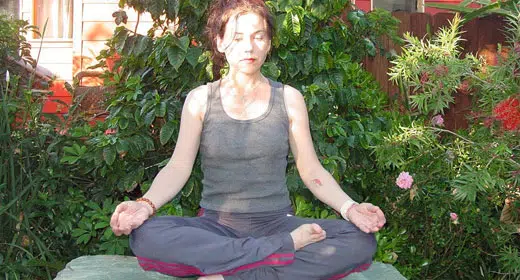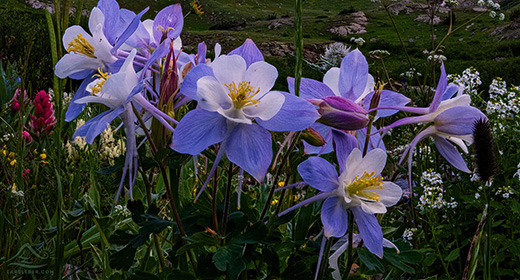by Donna Quesada: Who Am I—
 When I first began to practice Buddhism seriously, my teacher told me to meditate on the question Who Am I. In my youthful self-assurance, I thought no problem… I can solve this.
When I first began to practice Buddhism seriously, my teacher told me to meditate on the question Who Am I. In my youthful self-assurance, I thought no problem… I can solve this.
And then it all gets murky. Where do I start? Trivial physical attributes certainly don’t represent who “I” really am. After all, what is physical is subject to change. Science tells us that millions of cells in our body die everyday. But millions are then reborn to take their place. My body will change until I die. And then it will continue to change.
Nonetheless, I had to press on… Maybe there are certain molecules that aren’t subject to cellular demise. But the molecules themselves are composed of thousands of atoms, which in turn, are composed of electrons and protons and particles of energy, which in their turn, are composed of quarks and other subatomic particles… and those are composed of nothing but forces. After that, we just have theory.
The point is, no matter what fundamental element I try to isolate, so as to answer the question Who Am I, it either disintegrates into nothing, or has to be taken on faith.
Perhaps it’s more abstract than that, I thought. Maybe my talents make me, me. But these change, too. Due to injuries, like many former dancers and athletes, I can not dance like I did when I was a professional dancer. That was a long time ago. Use it or lose it applies here. So, like everyone else, I developed and strengthened other talents in its place. So, which talent is the real one? This is getting pretty silly. Perhaps I’m nothing more than my hopes and my dreams. Or my memories. But these things also morph with maturity. Memory is certainly selective…we remember what we want to remember. And it dulls with age.
So, when all of that goes… when the body goes, when the talents go, when the memory goes, where do YOU go?
In my mind, I continued on. Maybe it’s as the big religions tell us… I am my Soul. Maybe there is an essence deep within me that is always there… You peel away the transitory features, like an onion, until you get to the real thing… the seedling that makes us… us. Like those Russian dolls, where you keep opening them up to find another, then another. Maybe the soul is somewhere in there.
The Basis of Understanding Is Impermanence—
I began to see that Buddhist teachings present the world in terms of what we can actually experience, right here, right now. In that way, it is the ultimate empirical science. While it doesn’t directly negate the existence of a permanent soul, Buddhist teachings hold that it is simply beyond our ability to even conjecture. Besides, it has no bearing on the quality of our lives in real time. In other words, the question of the existence of the soul—whatever that is—is as impractical and impossible to confirm, as knowing what you will eat for breakfast in 2056… if you happen to be alive.
For Buddha, the most indisputable fact of existence is impermanence. Everything changes. Anything beyond what is experienced is speculation. And what matters is our quality of life, as we actually experience it. So the soul, as an eternal, unchanging essence, will have to be put to the side as nothing more than a philosophical curiosity.
I Think Therefore I Am—
But… I am a philosopher, so I couldn’t let it go just yet… I thought of Descartes. I think therefore I am. The fact that I am thinking confirms my existence, doesn’t it? Maybe, maybe not… because “I am” what, exactly? Anyway, thoughts are the paradigm of the ephemeral! Where are my thoughts? My Zen teacher would have said “show me your thoughts!” They are harder to catch than a shooting star. Even my consciousness is fleeting… and even the fact that I am conscious of my thoughts is delicate, since any number of bizarre things may happen to disrupt this consciousness, e.g., if the conditions were right, I may fall asleep, space out, faint, etc. Consciousness itself is totally dependent on a multitude of other factors, such as health, food, oxygen, air pressure, and other internal and external conditions.
I thought, this is becoming weird, like when you stare at a word too long and it begins to look strange, and it loses all meaning.
That’s the whole point of the meditation… Who Am I?
We Are a Rainbow—
We are more like a rainbow, which exists until you try to find it. Because like consciousness, there is no rainbow apart from the conditions which create it. And the conditions themselves, like moisture and light, are always in flux. So, when the conditions change too much, the rainbow disappears.
Thus, the rainbow isn’t so much a “thing,” as it is an active phenomena.
This is true for anything. And this is the big point. Take lightening as another example … For convenience, we give it a name, but there is no substratum or “thing” beyond the cause and effect action of the electrically charged particles in the clouds.
Everything is Dependent On Everything Else—
In this way, Buddhism says we are a composite of elements, which Buddha called skandhas, including our body, our feelings, our perceptions, our dispositions, and our consciousness, all of which are continuously in flux. And all of which depend on an infinite number of other things, in order to continue existing, such as the food we eat, the water we drink, the air we breathe, and the multitude of conditions that make all of that possible… like soil, trees, rain, and sunlight. But then, there’s also the farmers who pick the food, the trucks that transport the food, the gas that fuels the trucks, the roads for the trucks… you get the idea. It’s infinite. And it’s all mutually dependent and inter-connected.
That is to say, everything depends on everything else.
In summary, what I call “me”… and what you call “you,” is dependent on and connected up with everything else in the universe. From the Buddhist point of view, there’s no “you” apart from the conditions that sustain you. And it’s all in a state of continuous movement, so our “I” is more like a verb rather than a thing.
This is why anything and everything in reality boils down to nothing.
What is reality? It is infinite inside and out… In other words, looking out to space… where it stops, nobody knows… And looking inward, into our very cells… when do we get to the smallest “thing”? We don’t! It is infinite. As Buddha said more than 2500 years ago, there is nothing.
There is NO. THING.
But… Whatever “we” are… we are all connected. Whatever “it” is, we are part of it. All is one. Yet there is nothing tangible there… We are without singularity or individuality, as strange as that sounds. Hence the term “emptiness,” or shunyatta. There is nothing material, as was explained above.
Beyond Birth and Death—
Thinking in this way takes us beyond birth and death, since nothing is ever created or destroyed, but rather transformed… as the water droplets are transformed into the cloud, which is again transformed back into water droplets, which is later transformed into the food we eat, thanks to the help of everything else that exists.
It all goes back to Buddha’s first teaching of impermanence. Unlike the creation story, we don’t just magically pop into existence from nowhere. We were always there in the form of all the conditions necessary for our existence. Time is one of those conditions. We used to be a raindrop.
This is also what cyclical thinking means… we manifest as this or as that, depending on the conditions. And then we die… so to speak… because we don’t disappear, we morph into something else. It’s just a confluence of events, like the rainbow. I am my personality traits, my memory, my imagined past and future, my name, my body… I’m all of it, for a second. And I’m also none of it.
Buddhism is fine with that mystery space between categories. I am, but I’m not. It is the ultimate challenge to the ordinary way of seeing the self. We are but we aren’t. We die but we’re infinite. All beings are part of us.
I am he
As you are he
As you are me
And we are all together
~The Beatles









































